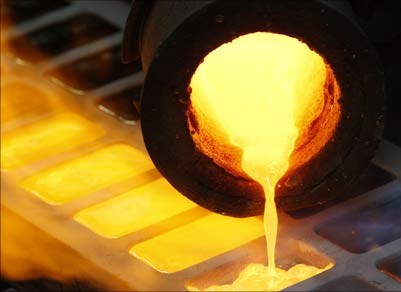
In China, gold production has increased for the eleventh consecutive year. China is the world largest gold producer for the third time in history with 345 tonnes of gold produced this year. Among the top gold-producing countries, China, with its increasing gold production, seems to go against the general trend of decreasing gold production. China has already announced that its gold production is expected to increase to up to 400 tonnes within the next three years.
Of the other major gold producing nations, Australia is the world’s second largest gold producer with a gold production of 255 tonnes in 2010 (+15%). However, this remains 20% below its peak level of production of 1998. In the United States, production of gold has been declining since 1998 (-37%) but has stabilized at around 230 tonnes per year over the last 4 years.
Gold production in South Africa, on the other hand, continues to decline. Until 2006, this country was once the world’s top producer but after almost a century of hegemony its ranking declined to the second position in 2007 and now fourth in 2010. Gold production in South Africa has decreased by 80% within the last 40 years. It is interesting to point out that 2010 Chinese gold production represents only a third of South Africa’s peak production in the late 1960s.
In 2010, Russia maintained its gold production at the same level; about 190 tonnes. While gold production in Peru is still below its peak production of 2005 (208 tonnes of gold) now producing just 170 tonnes of gold in 2010. Although one can identify more than three hundred mines in Peru, more than half of Peru’s production comes from two major gold mines. Indonesia produced 120 tonnes of gold in 2010, down 27% since its peak production in 2006. Half of Indonesia’s production is produced by one single company where production declined by 7% in 2010. And Canada also remains well below its peak production levels (166 tonnes of gold in 1941; and 177 tonnes of gold in 1991) with just 90 tonnes of gold produced in 2010.
The share of small gold-producing countries (Argentina, Bolivia, Brazil, Chile, Colombia, Ghana, Kazakhstan, Mali, Mexico, Morocco, Uzbekistan, Papua, Philippines, Tanzania, etc.) now account for more than a third of world gold production in 2010. This figure was less than 10% in 1969. These days, to find new deposits of gold, mining companies must go deeper into challenging territories such as deserts, rainforests and polar regions.
As a result of lower production costs due to 2008 crisis effects there is a temporary increase in the world production of gold. Since the crisis, global production increased by 240 tonnes reaching 2,500 tonnes in 2010 but short of the peak gold production reached in 2001 of 2,600 tonnes. But going forward, in the next 10 or 20 years, gold production will almost certainly decrease because of the lack of quality gold reserves.
For the original article, CLICK HERE.
From the article entitled, “World Production of Gold, 2011” by Dr. Thomas Chaize author of the Mining and Energy Newsletter. The information provided herein has been provided to MiningFeeds.com by the author and, as such, is subject to our disclaimer: CLICK HERE.



 Follow us on Twitter
Follow us on Twitter Become our facebook fan
Become our facebook fan










Comments are closed.